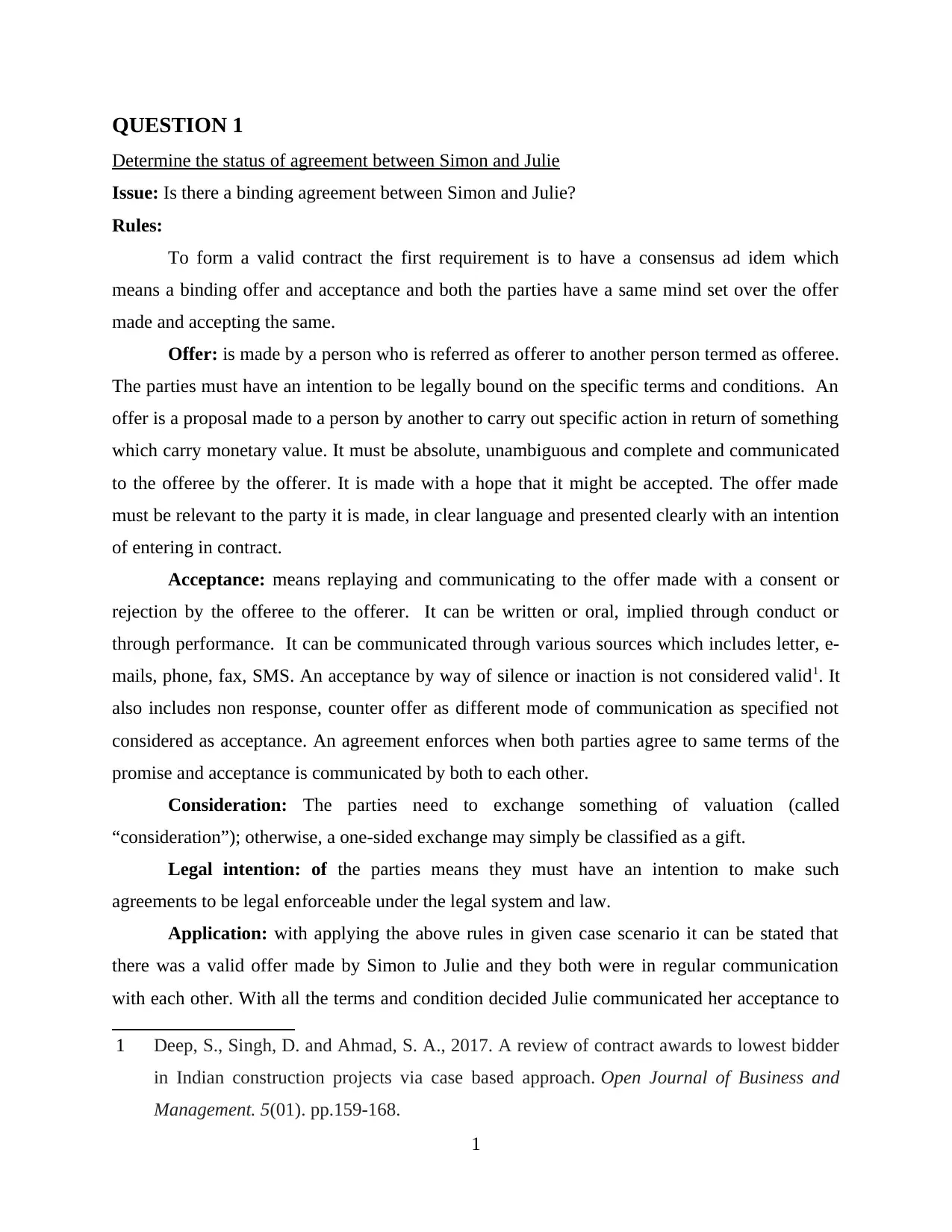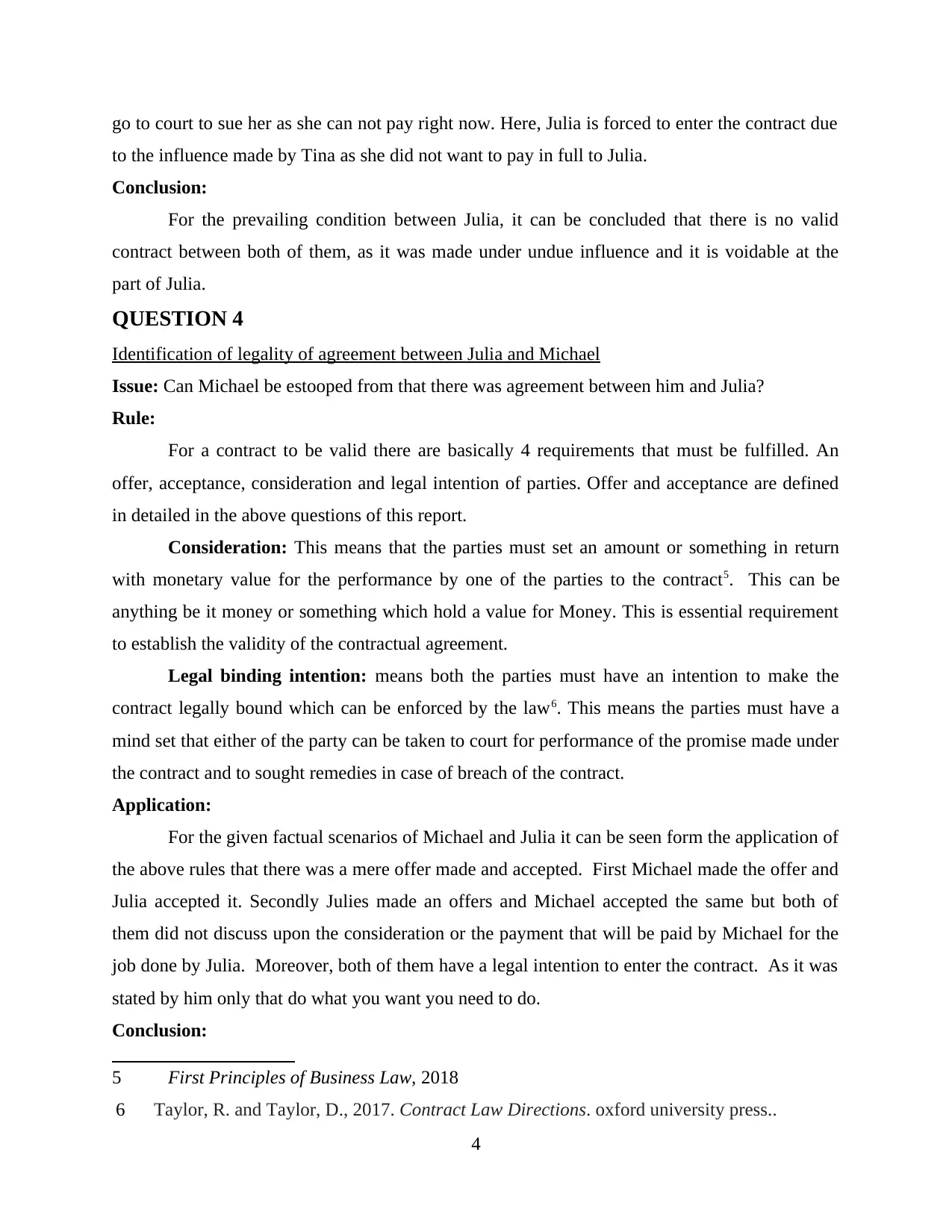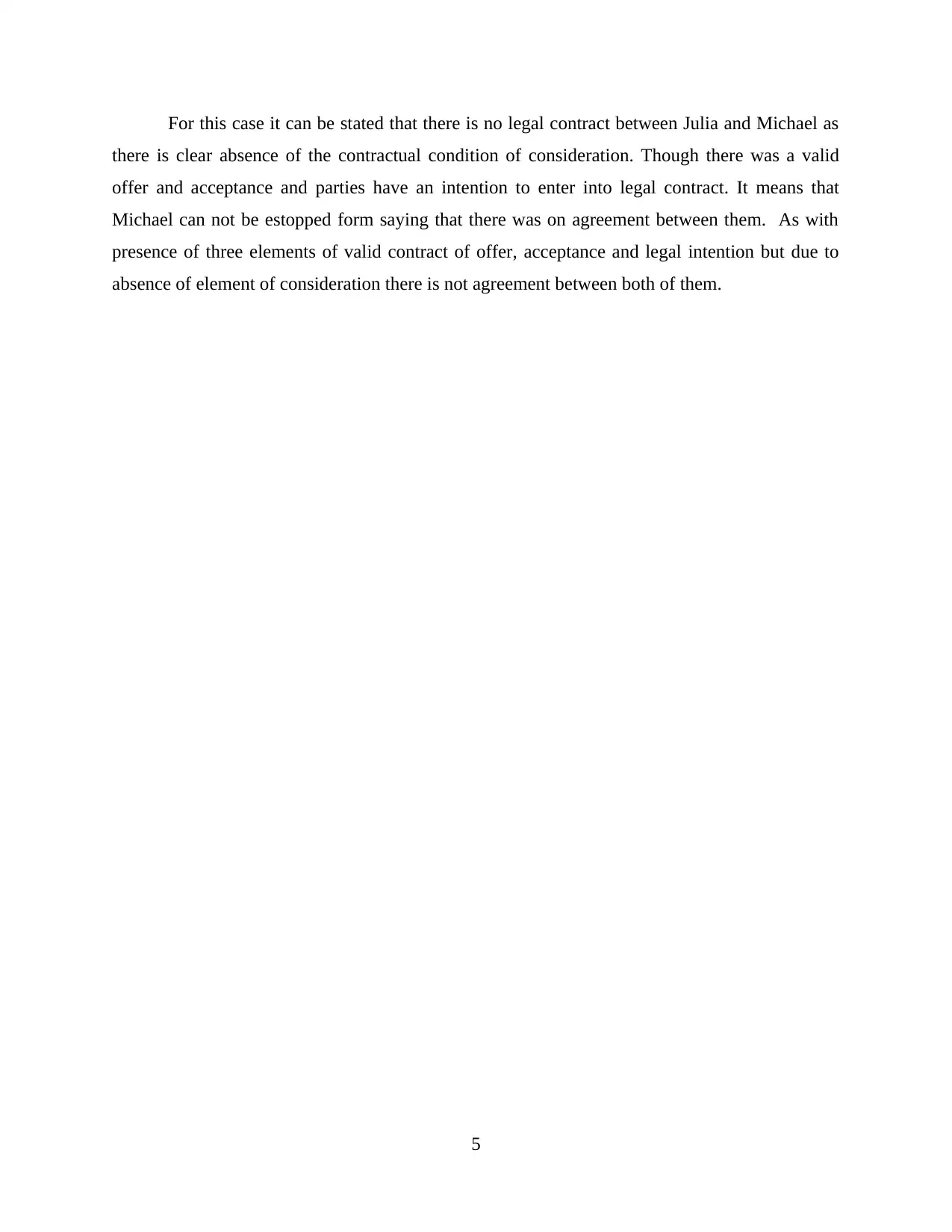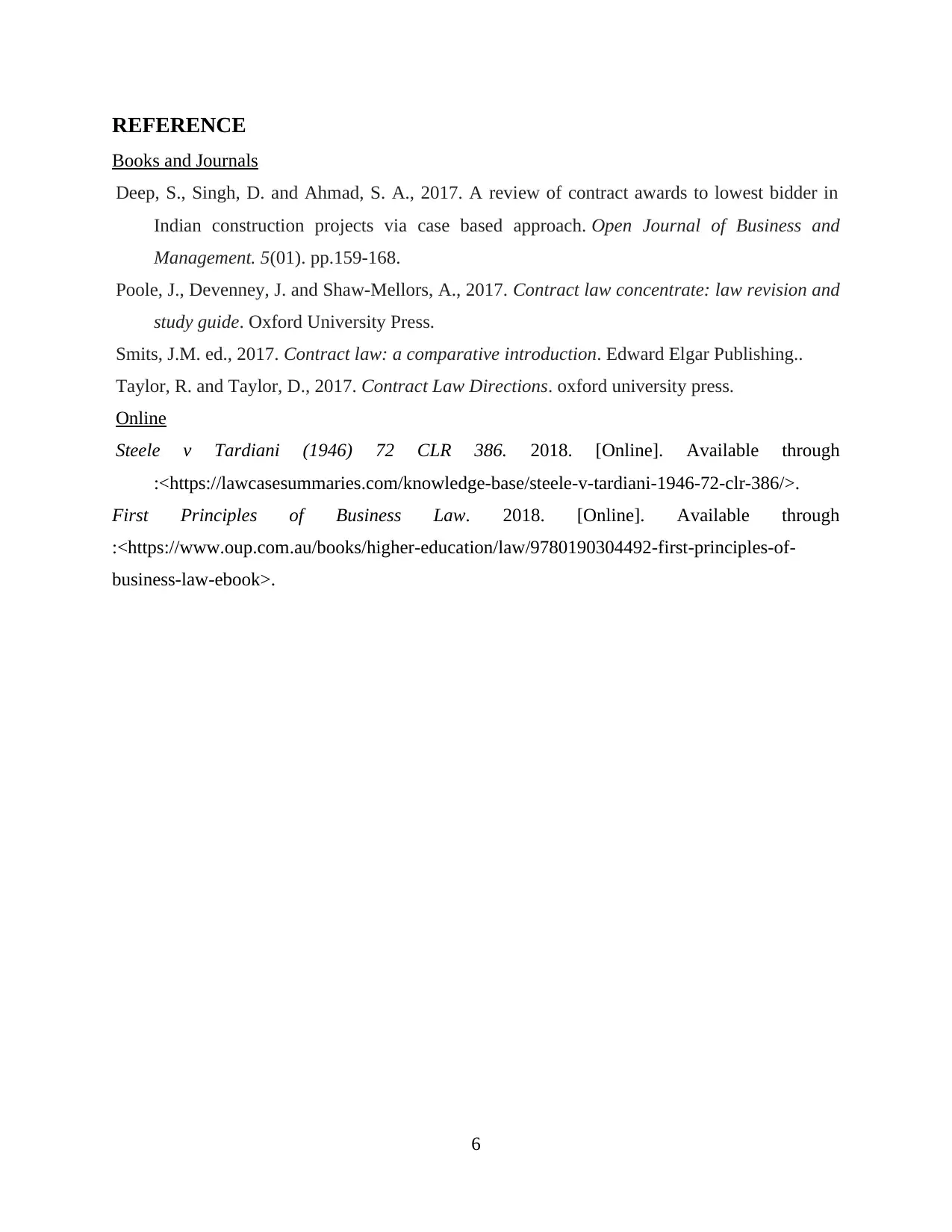Business Law and Ethics: Contractual Agreements and Legal Status
VerifiedAdded on 2020/12/29
|8
|2026
|284
Homework Assignment
AI Summary
This assignment analyzes several scenarios related to business law and ethics, focusing on the formation and validity of contracts. The analysis begins by examining the lack of a valid agreement between Simon and Julie due to the absence of acceptance. It then explores the nature of agreements between friends, concluding that the conversation between Julie and Peter did not constitute a legally binding contract because it occurred within a social context. The assignment also investigates the legal status of a new agreement between Julie and Tina, determining that it was made under undue influence and is therefore voidable. Finally, it addresses the legality of the agreement between Julia and Michael, concluding that there was no valid contract due to the absence of consideration, even though the elements of offer, acceptance, and legal intention were present. The assignment utilizes legal principles to assess the enforceability of different agreements.

Introduction to Business
Law ans Ethics
Law ans Ethics
Paraphrase This Document
Need a fresh take? Get an instant paraphrase of this document with our AI Paraphraser

Table of Contents
QUESTION 1 ..................................................................................................................................1
Determine the stats of agreement between Simon and Julie.......................................................1
QUESTION 2 ..................................................................................................................................2
Effect of the conversation between Julie and Peter....................................................................2
QUESTION 3...................................................................................................................................3
Determining the legal status of new agreement between Julia and Tina....................................3
QUESTION 4...................................................................................................................................4
Identification of legality of agreement between Julia and Michael............................................4
REFERENCE...................................................................................................................................5
QUESTION 1 ..................................................................................................................................1
Determine the stats of agreement between Simon and Julie.......................................................1
QUESTION 2 ..................................................................................................................................2
Effect of the conversation between Julie and Peter....................................................................2
QUESTION 3...................................................................................................................................3
Determining the legal status of new agreement between Julia and Tina....................................3
QUESTION 4...................................................................................................................................4
Identification of legality of agreement between Julia and Michael............................................4
REFERENCE...................................................................................................................................5

QUESTION 1
Determine the status of agreement between Simon and Julie
Issue: Is there a binding agreement between Simon and Julie?
Rules:
To form a valid contract the first requirement is to have a consensus ad idem which
means a binding offer and acceptance and both the parties have a same mind set over the offer
made and accepting the same.
Offer: is made by a person who is referred as offerer to another person termed as offeree.
The parties must have an intention to be legally bound on the specific terms and conditions. An
offer is a proposal made to a person by another to carry out specific action in return of something
which carry monetary value. It must be absolute, unambiguous and complete and communicated
to the offeree by the offerer. It is made with a hope that it might be accepted. The offer made
must be relevant to the party it is made, in clear language and presented clearly with an intention
of entering in contract.
Acceptance: means replaying and communicating to the offer made with a consent or
rejection by the offeree to the offerer. It can be written or oral, implied through conduct or
through performance. It can be communicated through various sources which includes letter, e-
mails, phone, fax, SMS. An acceptance by way of silence or inaction is not considered valid1. It
also includes non response, counter offer as different mode of communication as specified not
considered as acceptance. An agreement enforces when both parties agree to same terms of the
promise and acceptance is communicated by both to each other.
Consideration: The parties need to exchange something of valuation (called
“consideration”); otherwise, a one-sided exchange may simply be classified as a gift.
Legal intention: of the parties means they must have an intention to make such
agreements to be legal enforceable under the legal system and law.
Application: with applying the above rules in given case scenario it can be stated that
there was a valid offer made by Simon to Julie and they both were in regular communication
with each other. With all the terms and condition decided Julie communicated her acceptance to
1 Deep, S., Singh, D. and Ahmad, S. A., 2017. A review of contract awards to lowest bidder
in Indian construction projects via case based approach. Open Journal of Business and
Management. 5(01). pp.159-168.
1
Determine the status of agreement between Simon and Julie
Issue: Is there a binding agreement between Simon and Julie?
Rules:
To form a valid contract the first requirement is to have a consensus ad idem which
means a binding offer and acceptance and both the parties have a same mind set over the offer
made and accepting the same.
Offer: is made by a person who is referred as offerer to another person termed as offeree.
The parties must have an intention to be legally bound on the specific terms and conditions. An
offer is a proposal made to a person by another to carry out specific action in return of something
which carry monetary value. It must be absolute, unambiguous and complete and communicated
to the offeree by the offerer. It is made with a hope that it might be accepted. The offer made
must be relevant to the party it is made, in clear language and presented clearly with an intention
of entering in contract.
Acceptance: means replaying and communicating to the offer made with a consent or
rejection by the offeree to the offerer. It can be written or oral, implied through conduct or
through performance. It can be communicated through various sources which includes letter, e-
mails, phone, fax, SMS. An acceptance by way of silence or inaction is not considered valid1. It
also includes non response, counter offer as different mode of communication as specified not
considered as acceptance. An agreement enforces when both parties agree to same terms of the
promise and acceptance is communicated by both to each other.
Consideration: The parties need to exchange something of valuation (called
“consideration”); otherwise, a one-sided exchange may simply be classified as a gift.
Legal intention: of the parties means they must have an intention to make such
agreements to be legal enforceable under the legal system and law.
Application: with applying the above rules in given case scenario it can be stated that
there was a valid offer made by Simon to Julie and they both were in regular communication
with each other. With all the terms and condition decided Julie communicated her acceptance to
1 Deep, S., Singh, D. and Ahmad, S. A., 2017. A review of contract awards to lowest bidder
in Indian construction projects via case based approach. Open Journal of Business and
Management. 5(01). pp.159-168.
1
⊘ This is a preview!⊘
Do you want full access?
Subscribe today to unlock all pages.

Trusted by 1+ million students worldwide

the offer but Simon did not reply to the same as, he accept the work to be done by Julie at $3450.
Julie did not receive any communication of the acceptance from Simon for the quote sent by her.
Conclusion: It can be stated that there was no valid agreement between Simon and Julie
as it lack acceptance of the offer. For the acceptance made by Simon through SMS is not
complete till Julie reply to the same as she is ok with completing the job.
QUESTION 2
Effect of the conversation between Julie and Peter
Issue: Is there a legal binding agreement between Julia and Peter?
Rule
Valid elements of contract:
Offer and acceptance: for a contract an offer must be made which shall be accepted by
the person to whom it is made. In case of counter offer new offers is made and same shall also be
accepted. Both offerer and offeree must agree to same terms and condition under a promise to be
performed.
Consideration: there must be certain consideration for the completion of the promise
made which shall carry certain monetary value2. The consideration might be not be sufficient but
it must be there.
Legal binding intention: both the parties must have an intention to make it legal
binding. This requires an intention that the contract is enforceable by the law.
Contract under social relation or friends:
Agreement made between friends, to provide voluntary or charitable services do not carry
an intent to be legally binding. In such case who wants to treat agreement as legal have an onus
to impose additional conditions from which legal intention can bounds the other legally.
Case: Teen Ranch Pvt Ltd v Brown (1995):
For this case it was decided that there was not clear intent was showed by the both the
parties to have a legally binding relation hence there was no contract between both of them3.
Brown was not entitled for the worker compensation.
2 Poole, J., Devenney, J. and Shaw-Mellors, A., 2017. Contract law concentrate: law
revision and study guide. Oxford University Press.
3 Steele v Tardiani (1946) 72 CLR 386. 2018.
2
Julie did not receive any communication of the acceptance from Simon for the quote sent by her.
Conclusion: It can be stated that there was no valid agreement between Simon and Julie
as it lack acceptance of the offer. For the acceptance made by Simon through SMS is not
complete till Julie reply to the same as she is ok with completing the job.
QUESTION 2
Effect of the conversation between Julie and Peter
Issue: Is there a legal binding agreement between Julia and Peter?
Rule
Valid elements of contract:
Offer and acceptance: for a contract an offer must be made which shall be accepted by
the person to whom it is made. In case of counter offer new offers is made and same shall also be
accepted. Both offerer and offeree must agree to same terms and condition under a promise to be
performed.
Consideration: there must be certain consideration for the completion of the promise
made which shall carry certain monetary value2. The consideration might be not be sufficient but
it must be there.
Legal binding intention: both the parties must have an intention to make it legal
binding. This requires an intention that the contract is enforceable by the law.
Contract under social relation or friends:
Agreement made between friends, to provide voluntary or charitable services do not carry
an intent to be legally binding. In such case who wants to treat agreement as legal have an onus
to impose additional conditions from which legal intention can bounds the other legally.
Case: Teen Ranch Pvt Ltd v Brown (1995):
For this case it was decided that there was not clear intent was showed by the both the
parties to have a legally binding relation hence there was no contract between both of them3.
Brown was not entitled for the worker compensation.
2 Poole, J., Devenney, J. and Shaw-Mellors, A., 2017. Contract law concentrate: law
revision and study guide. Oxford University Press.
3 Steele v Tardiani (1946) 72 CLR 386. 2018.
2
Paraphrase This Document
Need a fresh take? Get an instant paraphrase of this document with our AI Paraphraser

Application: For the case of Peter and Julia it can be stated that it was a contract made
under social relation as Julie volunteered to take the job for the event at park. Both the parties
did not have an intention for creation of legally binding contract. Moreover, as per the case of
Brown and Teen it can also be established that both parties here did not express an in intention to
have a legally binding agreement between them.
Conclusion: it can be concluded that it was a mere agreement under the social relation
where no intention of legal binding was present. Hence, there is no legally binding agreement
between Peter and Julia.
QUESTION 3
Determining the legal status of new agreement between Julia and Tina
Issue: Is the new agreement between Julia and Tina is binding?
Rule:
Performance of the contract:
It can be defines as, when both the parties to the binding contract perform their part of the
obligation or promise made under the contract as expected and according to the terms of
contract. With this the contract comes to an end.
Problems with performance:
Partial performance: is performer of the contractual promise not in full rather anything
less than the completer performance is referred as partial performance. In this if the other party
have accepted the partial performance freely then it has a legal effect.
Undue influence: is a condition where party enters into a contract due to the influence of
other party. It is established when the person who entered the contract was not influences by the
other and on the basis of their relationship4. Such type of contract is voidable at the end of
influenced party and it can rescind the contract any time.
Application:
With the given facts it can be stated that there was partial performance on the side of Tina
as she wants to pay only $1500 to Julie and entering in a new contract where she can get her new
jobs. Moreover, the new terms and condition are placed Tina as she has clearly stated Julia can
4 Smits, J.M. ed., 2017. Contract law: a comparative introduction. Edward Elgar
Publishing..
3
under social relation as Julie volunteered to take the job for the event at park. Both the parties
did not have an intention for creation of legally binding contract. Moreover, as per the case of
Brown and Teen it can also be established that both parties here did not express an in intention to
have a legally binding agreement between them.
Conclusion: it can be concluded that it was a mere agreement under the social relation
where no intention of legal binding was present. Hence, there is no legally binding agreement
between Peter and Julia.
QUESTION 3
Determining the legal status of new agreement between Julia and Tina
Issue: Is the new agreement between Julia and Tina is binding?
Rule:
Performance of the contract:
It can be defines as, when both the parties to the binding contract perform their part of the
obligation or promise made under the contract as expected and according to the terms of
contract. With this the contract comes to an end.
Problems with performance:
Partial performance: is performer of the contractual promise not in full rather anything
less than the completer performance is referred as partial performance. In this if the other party
have accepted the partial performance freely then it has a legal effect.
Undue influence: is a condition where party enters into a contract due to the influence of
other party. It is established when the person who entered the contract was not influences by the
other and on the basis of their relationship4. Such type of contract is voidable at the end of
influenced party and it can rescind the contract any time.
Application:
With the given facts it can be stated that there was partial performance on the side of Tina
as she wants to pay only $1500 to Julie and entering in a new contract where she can get her new
jobs. Moreover, the new terms and condition are placed Tina as she has clearly stated Julia can
4 Smits, J.M. ed., 2017. Contract law: a comparative introduction. Edward Elgar
Publishing..
3

go to court to sue her as she can not pay right now. Here, Julia is forced to enter the contract due
to the influence made by Tina as she did not want to pay in full to Julia.
Conclusion:
For the prevailing condition between Julia, it can be concluded that there is no valid
contract between both of them, as it was made under undue influence and it is voidable at the
part of Julia.
QUESTION 4
Identification of legality of agreement between Julia and Michael
Issue: Can Michael be estooped from that there was agreement between him and Julia?
Rule:
For a contract to be valid there are basically 4 requirements that must be fulfilled. An
offer, acceptance, consideration and legal intention of parties. Offer and acceptance are defined
in detailed in the above questions of this report.
Consideration: This means that the parties must set an amount or something in return
with monetary value for the performance by one of the parties to the contract5. This can be
anything be it money or something which hold a value for Money. This is essential requirement
to establish the validity of the contractual agreement.
Legal binding intention: means both the parties must have an intention to make the
contract legally bound which can be enforced by the law6. This means the parties must have a
mind set that either of the party can be taken to court for performance of the promise made under
the contract and to sought remedies in case of breach of the contract.
Application:
For the given factual scenarios of Michael and Julia it can be seen form the application of
the above rules that there was a mere offer made and accepted. First Michael made the offer and
Julia accepted it. Secondly Julies made an offers and Michael accepted the same but both of
them did not discuss upon the consideration or the payment that will be paid by Michael for the
job done by Julia. Moreover, both of them have a legal intention to enter the contract. As it was
stated by him only that do what you want you need to do.
Conclusion:
5 First Principles of Business Law, 2018
6 Taylor, R. and Taylor, D., 2017. Contract Law Directions. oxford university press..
4
to the influence made by Tina as she did not want to pay in full to Julia.
Conclusion:
For the prevailing condition between Julia, it can be concluded that there is no valid
contract between both of them, as it was made under undue influence and it is voidable at the
part of Julia.
QUESTION 4
Identification of legality of agreement between Julia and Michael
Issue: Can Michael be estooped from that there was agreement between him and Julia?
Rule:
For a contract to be valid there are basically 4 requirements that must be fulfilled. An
offer, acceptance, consideration and legal intention of parties. Offer and acceptance are defined
in detailed in the above questions of this report.
Consideration: This means that the parties must set an amount or something in return
with monetary value for the performance by one of the parties to the contract5. This can be
anything be it money or something which hold a value for Money. This is essential requirement
to establish the validity of the contractual agreement.
Legal binding intention: means both the parties must have an intention to make the
contract legally bound which can be enforced by the law6. This means the parties must have a
mind set that either of the party can be taken to court for performance of the promise made under
the contract and to sought remedies in case of breach of the contract.
Application:
For the given factual scenarios of Michael and Julia it can be seen form the application of
the above rules that there was a mere offer made and accepted. First Michael made the offer and
Julia accepted it. Secondly Julies made an offers and Michael accepted the same but both of
them did not discuss upon the consideration or the payment that will be paid by Michael for the
job done by Julia. Moreover, both of them have a legal intention to enter the contract. As it was
stated by him only that do what you want you need to do.
Conclusion:
5 First Principles of Business Law, 2018
6 Taylor, R. and Taylor, D., 2017. Contract Law Directions. oxford university press..
4
⊘ This is a preview!⊘
Do you want full access?
Subscribe today to unlock all pages.

Trusted by 1+ million students worldwide

For this case it can be stated that there is no legal contract between Julia and Michael as
there is clear absence of the contractual condition of consideration. Though there was a valid
offer and acceptance and parties have an intention to enter into legal contract. It means that
Michael can not be estopped form saying that there was on agreement between them. As with
presence of three elements of valid contract of offer, acceptance and legal intention but due to
absence of element of consideration there is not agreement between both of them.
5
there is clear absence of the contractual condition of consideration. Though there was a valid
offer and acceptance and parties have an intention to enter into legal contract. It means that
Michael can not be estopped form saying that there was on agreement between them. As with
presence of three elements of valid contract of offer, acceptance and legal intention but due to
absence of element of consideration there is not agreement between both of them.
5
Paraphrase This Document
Need a fresh take? Get an instant paraphrase of this document with our AI Paraphraser

REFERENCE
Books and Journals
Deep, S., Singh, D. and Ahmad, S. A., 2017. A review of contract awards to lowest bidder in
Indian construction projects via case based approach. Open Journal of Business and
Management. 5(01). pp.159-168.
Poole, J., Devenney, J. and Shaw-Mellors, A., 2017. Contract law concentrate: law revision and
study guide. Oxford University Press.
Smits, J.M. ed., 2017. Contract law: a comparative introduction. Edward Elgar Publishing..
Taylor, R. and Taylor, D., 2017. Contract Law Directions. oxford university press.
Online
Steele v Tardiani (1946) 72 CLR 386. 2018. [Online]. Available through
:<https://lawcasesummaries.com/knowledge-base/steele-v-tardiani-1946-72-clr-386/>.
First Principles of Business Law. 2018. [Online]. Available through
:<https://www.oup.com.au/books/higher-education/law/9780190304492-first-principles-of-
business-law-ebook>.
6
Books and Journals
Deep, S., Singh, D. and Ahmad, S. A., 2017. A review of contract awards to lowest bidder in
Indian construction projects via case based approach. Open Journal of Business and
Management. 5(01). pp.159-168.
Poole, J., Devenney, J. and Shaw-Mellors, A., 2017. Contract law concentrate: law revision and
study guide. Oxford University Press.
Smits, J.M. ed., 2017. Contract law: a comparative introduction. Edward Elgar Publishing..
Taylor, R. and Taylor, D., 2017. Contract Law Directions. oxford university press.
Online
Steele v Tardiani (1946) 72 CLR 386. 2018. [Online]. Available through
:<https://lawcasesummaries.com/knowledge-base/steele-v-tardiani-1946-72-clr-386/>.
First Principles of Business Law. 2018. [Online]. Available through
:<https://www.oup.com.au/books/higher-education/law/9780190304492-first-principles-of-
business-law-ebook>.
6
1 out of 8
Related Documents
Your All-in-One AI-Powered Toolkit for Academic Success.
+13062052269
info@desklib.com
Available 24*7 on WhatsApp / Email
![[object Object]](/_next/static/media/star-bottom.7253800d.svg)
Unlock your academic potential
Copyright © 2020–2025 A2Z Services. All Rights Reserved. Developed and managed by ZUCOL.





